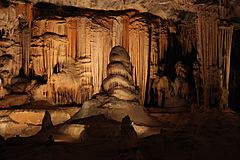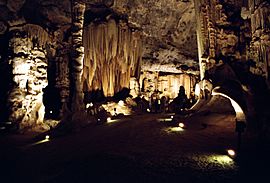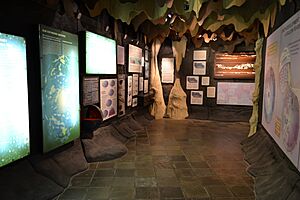Cango Caves facts for kids

Speleothems in the caves
|
|
| Location | foothills of the Swartberg, near Oudtshoorn |
|---|---|
| Region | South Africa |
| Coordinates | 33°23′34″S 22°12′53″E / 33.39278°S 22.21472°E |
| History | |
| Material | Precambrian limestone |
| Site notes | |
| Excavation dates | 1930 |
| Archaeologists | A.J.H. Goodwin |
The Cango Caves are amazing underground caverns. They are found in limestone rock near Oudtshoorn, a town in South Africa. These caves are very famous and a top spot for tourists.
The Cango Caves have many tunnels and rooms. The whole system stretches for over 4 kilometers (about 2.5 miles). But only about a quarter of it is open for visitors. You can only explore the caves with a guide.
Contents
Discovering the Cango Caves
People have used the Cango Caves for a very long time. Ancient cave paintings and tools show that humans lived here. They used the caves during the Middle Stone Age and Later Stone Age.
Modern Rediscovery
A local farmer named Jacobus Van Zyl rediscovered the caves in 1780. He was lowered into the first big room. This room was as long as a football field! It is now called Van Zyl Hall in his honor.
More exploration happened in 1792. A second large room was found. Soon, the caves became a popular place to visit.
Early Studies
In 1930, an archaeologist named A.J.H. Goodwin studied the caves. He found old stone tools and other items. These finds helped us learn about the ancient people who lived there.
Today, the local government manages the Cango Caves. They make sure the caves are protected and well-cared for.
Legends of the Caves
There are many stories about the Cango Caves. One famous story is about Johnny van Wassenaer. He was the first official cave guide.
In 1898, he supposedly walked for 29 hours inside the caves. He was trying to find the very end. He believed he was 25 kilometers (about 15.5 miles) from the entrance. He also thought he was 275 meters (about 900 feet) underground. His path may have followed an underground river. Explorers are still finding new caves that seem to support his amazing journey!
Exploring the Deep Caves
People have been mapping and exploring the Cango Caves for many years. They want to understand how big and complex the cave system is.
First Maps
The first rough map was made in 1897. It showed the first 26 rooms. In 1956, a group called the South African Spelaeological Association made a more accurate map. They also looked for other ways to enter the caves.
Their maps showed that the first part, called Cango I, was 775 meters (about 2,540 feet) long. It did not go up or down much, only about 16 meters (about 52 feet). The closest point to the surface in Cango I is 52.6 meters (about 172 feet) from the floor.
Discovering New Sections
In 1972, explorers James Craig-Smith, Luther Terblanche, and Dart Ruiters made a big discovery. They widened a blocked passage. This led them to Cango II. This new section stretched 270 meters (about 885 feet) past the Devil’s Kitchen area.
At the end of Cango II, there was a 20-meter (about 65-foot) shaft. It led to a room filled with water. This water flowed towards Cango I.
In 1975, a team drained most of the water from this room. They crawled through what was once an underwater passage. This led them to discover even more caves, called Cango III. These new caves are about 1,000 meters (about 3,280 feet) long. The biggest room in Cango III is about 300 meters (about 984 feet) long.
More parts of Cango III were found in 1977 and 1978. These discoveries added another 380 meters (about 1,246 feet) to the known cave system.
Visiting the Cango Caves
The Cango Caves are a popular tourist attraction. You can choose from different tours to explore them.
Types of Tours
- Standard Tour: This tour takes about an hour. You will see large halls and amazing limestone formations.
- Adventure Tour: This tour takes about an hour and a half. It is more exciting! You will crawl through narrow passages. You will also climb up steep rock formations. Guides use small lights to lead the way. The smallest passage on this tour is less than 15 centimeters (about 6 inches) high.
Both tours let you see the beautiful natural formations inside the caves. The caves are considered part of the famous R62 road route.






